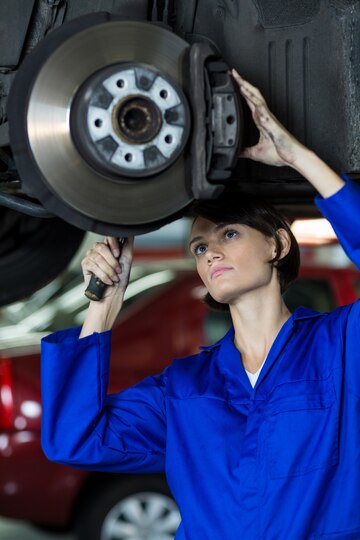Our cars are marvels of modern engineering, whisking us from point A to point B with speed and convenience. But for every exhilarating acceleration, there needs to be a safe and reliable deceleration – and that’s where your brakes come in. They’re arguably the most crucial safety feature on your vehicle, responsible for bringing you to a complete stop whenever needed.
However, like any hardworking component, brakes experience wear and tear over time. Neglecting regular maintenance can lead to decreased stopping power, increased stopping distances, and even complete brake failure – a scenario no driver wants to face.
Understanding Your Brake System
Before diving into why maintenance is essential, let’s explore the key components of your braking system:
1. Brake Pads: These friction materials make contact with the rotors, creating the stopping power. As you press the brake pedal, the pads clamp down on the rotors, converting your car’s kinetic energy into heat.
2. Brake Rotors: These discs are connected to your wheels and rotate with them. When you press the brake pedal, the pads clamp down on the rotors, slowing down the wheels and ultimately the car.
3. Brake Calipers: These house the brake pads and pistons. When you press the pedal, hydraulic pressure from the brake fluid pushes the pistons, forcing the pads against the rotors.
4. Brake Fluid: This hydraulic fluid transmits the pressure from the brake pedal to the calipers, activating the braking system.

Why Regular Maintenance Matters
Now that you understand the core components, let’s delve into why regular brake maintenance is crucial:
1. Safety First: Well-maintained brakes ensure optimal stopping power, allowing you to bring your car to a complete stop safely in any situation. This is especially important during emergencies or unpredictable situations on the road.
2. Preventative Measures: Regular maintenance helps identify potential problems early on, preventing costly repairs down the road. Worn brake pads can damage rotors, and neglecting fluid changes can lead to system inefficiencies. Early detection allows for timely repairs, saving you money and avoiding potential safety hazards.
3. Improved Performance: Over time, worn brake pads and warped rotors can lead to decreased stopping power and a spongy brake pedal feel. Regular maintenance ensures your brakes function optimally, providing a more responsive and predictable braking experience.
4. Extended Brake Life: Proper maintenance practices, like replacing worn brake pads before they damage the rotors, can significantly extend the overall lifespan of your braking system, saving you money on component replacements in the long run.
5. Fuel Efficiency: Worn brake pads can cause increased friction, leading to decreased fuel efficiency. Maintaining your brakes ensures optimal performance and can even improve your car’s gas mileage.
Signs You Need a Brake Check
Your car communicates its needs in subtle ways. Here are some signs that might indicate it’s time for a brake check:
1. Grinding or Squealing Noises: These noises occur when the brake pads wear down to their metal backing, grinding against the rotors. This is a clear sign you need immediate brake pad replacement.
2. Soft or Spongy Brake Pedal: A spongy pedal feel indicates air in the brake lines or a failing master cylinder. This can significantly reduce stopping power and requires professional attention.
3. Increased Stopping Distance: If you notice it takes longer than usual to bring your car to a complete stop, this could be a sign of worn brake pads, warped rotors, or other brake system issues.
4. Vibrations When Braking: Vibrations in the steering wheel or brake pedal during braking can indicate warped rotors or other problems requiring professional inspection.
5. Warning Light on Dashboard: Modern vehicles have a brake system warning light that illuminates when there’s a problem. Never ignore this – get your car checked immediately.
Taking Care of Your Brakes: Maintenance Tips
1. Schedule Regular Brake Inspections: Consult your car’s owner’s manual for recommended brake inspection intervals. Typically, this is every 12,000 to 15,000 miles or once a year.
2. Replace Brake Pads When Needed: Brake pads wear down at varying rates depending on driving habits. Most mechanics can recommend replacement based on pad thickness during inspections.
3. Maintain Proper Brake Fluid Levels: Brake fluid absorbs moisture over time, affecting its performance. Regular fluid changes, usually every 2-3 years, are essential.
4. Practice Good Driving Habits: Avoid harsh braking, excessive use of brakes while going downhill, and overloading your vehicle. These habits accelerate brake pad wear and tear.
Invest in Your Safety: Prioritize Brake Maintenance
Your brakes are the silent guardians of your safety on the road. By prioritizing regular brake maintenance, you ensure optimal performance, prevent costly repairs, and most importantly, guarantee peace of mind behind the wheel. Remember, a few minutes spent at the mechanic for a brake check can prevent a major safety hazard and a potentially life-changing situation on the road.
Taking Action: Finding a Reputable Mechanic
Finding a qualified mechanic for your brake maintenance is crucial. Look for a service center with certified technicians experienced in brake system repairs. Read online reviews, ask friends and family for recommendations, and don’t hesitate to ask questions about the recommended services.
The Road to Safe Driving Starts with Your Brakes
Regular brake maintenance isn’t an expense; it’s an investment in your safety and the safety of those on the road with you. Don’t wait for warning signs – prioritize proactive maintenance and ensure your brakes are always ready to bring you to a safe stop.
Hit the road with confidence, knowing your brakes are in top condition. Schedule your next brake maintenance appointment today!

